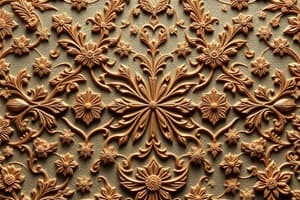Podcast
Questions and Answers
Find the next number in the sequence: 2, 6, 12, 20, 30, ?
Find the next number in the sequence: 2, 6, 12, 20, 30, ?
- 44
- 40 (correct)
- 42
- 36
If all zebras are animals, and all animals have cells, which of the following is true?
If all zebras are animals, and all animals have cells, which of the following is true?
- Zebras do not have cells.
- All animals are zebras.
- All zebras have cells. (correct)
- Some animals do not have cells.
If the statement 'All birds can fly' is false, which of the following must be true?
If the statement 'All birds can fly' is false, which of the following must be true?
- Some birds cannot fly. (correct)
- All birds cannot fly.
- No birds can fly.
- Some birds can fly.
What is the relationship between the pairs? SUN:DAY::MOON:?
What is the relationship between the pairs? SUN:DAY::MOON:?
HAND is to GLOVE as FOOT is to:
HAND is to GLOVE as FOOT is to:
Which word does not belong in the following list?
Which word does not belong in the following list?
Given the following table of numbers, find the sum of the diagonal from top left to bottom right:
Given the following table of numbers, find the sum of the diagonal from top left to bottom right:
If the pattern is ABC, BCD, CDE, what comes next?
If the pattern is ABC, BCD, CDE, what comes next?
What is the sum of the diagonal from top right to bottom left in the provided table?
What is the sum of the diagonal from top right to bottom left in the provided table?
What comes next in the pattern XW, WV, UV?
What comes next in the pattern XW, WV, UV?
If 5y + 3 = 28, what is the value of y?
If 5y + 3 = 28, what is the value of y?
What is the next number in the sequence: 3, 6, 9, 12, ?
What is the next number in the sequence: 3, 6, 9, 12, ?
If all squares are rectangles and some rectangles are triangles, which statement is true?
If all squares are rectangles and some rectangles are triangles, which statement is true?
What is the correct analogy for WATER:OCEAN::SAND:?
What is the correct analogy for WATER:OCEAN::SAND:?
Identify the next number in the sequence: 1, 4, 9, 16, 25, ?
Identify the next number in the sequence: 1, 4, 9, 16, 25, ?
If some professionals are teachers, which of the following can be deduced regarding doctors?
If some professionals are teachers, which of the following can be deduced regarding doctors?
If 'Some fruits are apples' is true, which statement must also be true?
If 'Some fruits are apples' is true, which statement must also be true?
What is the relationship between the pairs? TREE:FOREST::FLOWER:?
What is the relationship between the pairs? TREE:FOREST::FLOWER:?
KNIFE is to CUT as PEN is to:
KNIFE is to CUT as PEN is to:
Which word is an anomaly in the following list?
Which word is an anomaly in the following list?
In the shape sequence, what comes next?
In the shape sequence, what comes next?
If A is to B as C is to D, which statement is most accurate?
If A is to B as C is to D, which statement is most accurate?
Flashcards are hidden until you start studying
Study Notes
Logical Thinking Quiz Overview
- The quiz aims to assess logical reasoning and problem-solving skills through rules and mathematical concepts.
- It includes a variety of question types including pattern recognition, argument analysis, and analogies.
Identifying Patterns
- Sequence provided: 2, 6, 12, 20, 30.
- Next number determined to be 42, following a specific numerical pattern.
Analyzing Arguments
- All zebras are included within the category of animals, and all animals possess cells.
- Correct conclusion drawn: All zebras have cells.
Drawing Conclusions
- The statement "All birds can fly" serves as a false premise.
- Valid conclusion: Some birds cannot fly, recognizing that the false statement allows for exceptions.
Interpreting Relationships
- Relationship comparison: SUN is to DAY as MOON is to NIGHT.
- Logical answer derived is NIGHT based on contextual relationships between pairs.
Identifying Analogies
- HAND corresponds to GLOVE in terms of protective covering.
- Following the analogy, FOOT relates to SHOE as the protective covering for feet.
Identifying Anomalies
- Words presented: Cat, Dog, Rabbit, Car.
- Anomaly identified as Car, which is not a living creature, unlike the others.
Using Graphics/Shapes
- Questions include the identification of what shape follows a visible sequence.
- Requires visual pattern continuity, dependent on the graphics provided.
Using Tables
- Sum of the diagonal in the given 3x3 grid calculated.
- Total calculated: 21, derived from values 1, 5, and 9 in the table.
Using Patterns
- Sequence of letters given: ABC, BCD, CDE.
- Next segment identified as DEF based on sequential alphabetical progression.
Mathematical Concepts
- Algebraic equation presented: 3x - 2 = 13.
- Solution found through basic algebra, resulting in x = 5.
Logical Thinking Quiz Overview
- Designed to enhance analytical skills and problem-solving abilities using logical and mathematical concepts.
- Questions have no time limit, encouraging careful consideration and thought.
Question Types
- Identifying Patterns: Recognizes sequences and progression, like squares in a numerical sequence.
- Analyzing Arguments: Evaluates logical statements and their implications, assessing conclusions drawn from premises.
- Drawing Conclusions: Infers truths based on given statements; understanding what must be true if initial premises are valid.
- Interpreting Relationships: Compares pairs of concepts to determine analogous connections or associative meanings.
- Identifying Analogies: Examines connections between words or concepts, usually by defining the function or action.
- Identifying Anomalies: Spotting the odd item in a list based on shared characteristics.
- Using Graphics/Shapes: Predicts the continuation of visual sequences based on observed changes.
- Using Tables: Calculates specific values from structured sets of numbers, often involving diagonal or other patterns.
- Using Patterns: Recognizes patterns in letters or numbers, requiring forethought about alphabetic or numeric sequences.
- Mathematical Concepts: Deals with basic algebraic problems, aimed at solving for unknown values through equations.
Specific Examples
- Sequence Identification: E.g., squares of natural numbers like 1, 4, 9 (1², 2², 3²).
- Logical Argument Analysis: Connection between professions, e.g., doctors and teachers.
- Truth Assertions: Evaluating conditions like “No mammals are fish” to infer about other groups.
- Relationship Analogy: E.g., understanding that trees belong in forests similarly as flowers belong in gardens.
- Functional Analogies: Relating tools to their purpose, such as a knife for cutting or a pen for writing.
- Odd Item Identification: Differentiating transport modes, where an apple is unrelated among vehicles.
- Shape Sequences: Predicting the next shape based on geometric patterns.
- Diagonal Sums: Extracting values from a two-dimensional array and performing operational tasks.
- Pattern Recognition: Recognizing sequences in letter pairs (e.g., backward movement through the alphabet).
- Algebraic Problem Solving: Applying arithmetic rules to isolate variables within an equation.
Format and Clarity
- Maintained clarity in organizing different types of logical reasoning questions.
- Emphasizes understanding both verbal and numerical logic for comprehensive skill assessment.
Studying That Suits You
Use AI to generate personalized quizzes and flashcards to suit your learning preferences.




